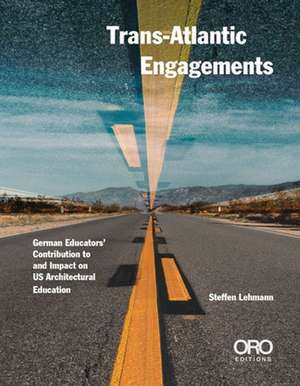Transatlantic
Autor Peter Bosselmannen Limba Engleză Paperback – 7 mar 2021
Preț: 181.46 lei
Nou
Puncte Express: 272
Preț estimativ în valută:
34.72€ • 36.34$ • 28.90£
34.72€ • 36.34$ • 28.90£
Carte disponibilă
Livrare economică 10-24 martie
Preluare comenzi: 021 569.72.76
Specificații
ISBN-13: 9781951541484
ISBN-10: 1951541480
Pagini: 200
Dimensiuni: 229 x 178 x 17 mm
Greutate: 0.61 kg
Editura: ACC Art Books
ISBN-10: 1951541480
Pagini: 200
Dimensiuni: 229 x 178 x 17 mm
Greutate: 0.61 kg
Editura: ACC Art Books
Notă biografică
Dr. Steffen Lehmann is a full-time professor of Architecture and immediate past Director of the School of Architecture at the University of Nevada, Las Vegas (UNLV). He is Director of the Future Cities Leadership Institute. As Head of School in Australia, he was responsible for over 3,000 students and 150 academic, professional and casual staff, with offshore programs in Malaysia and Hong Kong.
Cuprins
Part I. Early German Influences, Immigration and Assimilation
1. Drawing from two different European systems of architectural education 29
2. The development of German architectural education in the 19th century 36
3. Modest beginnings: The first US departments and curricula of architecture 41
4. Other German influences 47
5. The legacy of Gropius and Mies and the influential Bauhaus methods 49
6. The Bauhaus movement's transformative pedagogical ideals 53
Appendix Part I. The Historical Cases and a Timeline of 200 Years 61
Biographies of 52 recognised 19th and 20th century German-speaking architects in the US
Part II. Consolidation of the Modernist Approach in US Architectural Education
1. Leaving Germany, embracing new challenges: First to the UK, then coming
to America 86
2. Gropius's power struggles at the GSD at Harvard 91
3. The lasting legacy of Mies van der Rohe at the IIT in Chicago 98
4. Teaching Mies: The Miesian step-by-step approach to learning 100
5. Critcal reflection on Gropius and Mies 107
6. The language of space: Other places, where the Bauhaus pedagogy blossomed 110
7. The Bauhaus pedagogy reflected back to Europe through Hoesli at the ETH 115
8. Consolidation of the Modernist approach in 1950s US architectural education 116
9. The banality of Modernism and the end of the Modernist doctrine of Functionalism 118
Appendix Part II. The Current Context and a Map 124
A contemporary overview: short biographies of 39 immigrated educators
currently active in the US
Part III. Trans-Atlantic Engagements Today: German Educators Currently at
US Schools of Architecture
1. Examining the current context: a diversity of pedagogical positions 135
2. Immigration and positive assimilation into American society 139
3. Why teaching? On the attractiveness of being an educator and writer 145
4. German educators influencing contemporary architectural education and
future practice 150
5. The dilemma of research and scholarship in architectural education 155
6. An impact-driven and research-based curriculum for 21st-century
architectural education? 162
Appendix Part III. The Interviews with Current Educators 167
Conversations with the Author: Six German-trained Educators
Conversation with Professor Martin Bechthold, Cambridge 169
Conversation with Professor Peter Bosselmann, Berkeley 174
Conversation with Professor Ulrike Heine, Clemson 179
Conversation with Professor Barbara Klinkhammer, Philadelphia 184 Conversation with Professor Mark Mueckenheim, San Francisco 189
Conversation with Professor Antje Steinmuller, San Francisco 194
1. Drawing from two different European systems of architectural education 29
2. The development of German architectural education in the 19th century 36
3. Modest beginnings: The first US departments and curricula of architecture 41
4. Other German influences 47
5. The legacy of Gropius and Mies and the influential Bauhaus methods 49
6. The Bauhaus movement's transformative pedagogical ideals 53
Appendix Part I. The Historical Cases and a Timeline of 200 Years 61
Biographies of 52 recognised 19th and 20th century German-speaking architects in the US
Part II. Consolidation of the Modernist Approach in US Architectural Education
1. Leaving Germany, embracing new challenges: First to the UK, then coming
to America 86
2. Gropius's power struggles at the GSD at Harvard 91
3. The lasting legacy of Mies van der Rohe at the IIT in Chicago 98
4. Teaching Mies: The Miesian step-by-step approach to learning 100
5. Critcal reflection on Gropius and Mies 107
6. The language of space: Other places, where the Bauhaus pedagogy blossomed 110
7. The Bauhaus pedagogy reflected back to Europe through Hoesli at the ETH 115
8. Consolidation of the Modernist approach in 1950s US architectural education 116
9. The banality of Modernism and the end of the Modernist doctrine of Functionalism 118
Appendix Part II. The Current Context and a Map 124
A contemporary overview: short biographies of 39 immigrated educators
currently active in the US
Part III. Trans-Atlantic Engagements Today: German Educators Currently at
US Schools of Architecture
1. Examining the current context: a diversity of pedagogical positions 135
2. Immigration and positive assimilation into American society 139
3. Why teaching? On the attractiveness of being an educator and writer 145
4. German educators influencing contemporary architectural education and
future practice 150
5. The dilemma of research and scholarship in architectural education 155
6. An impact-driven and research-based curriculum for 21st-century
architectural education? 162
Appendix Part III. The Interviews with Current Educators 167
Conversations with the Author: Six German-trained Educators
Conversation with Professor Martin Bechthold, Cambridge 169
Conversation with Professor Peter Bosselmann, Berkeley 174
Conversation with Professor Ulrike Heine, Clemson 179
Conversation with Professor Barbara Klinkhammer, Philadelphia 184 Conversation with Professor Mark Mueckenheim, San Francisco 189
Conversation with Professor Antje Steinmuller, San Francisco 194
